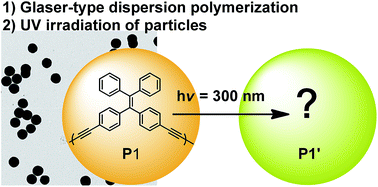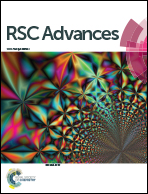Tetraphenylethene–diyne hybrid nanoparticles from Glaser-type dispersion polymerization†
Abstract
Organic-based nanoparticles hold great potential for optoelectronics and biomedicine as they may provide optical properties in the visible range and notable advantages over inorganic counterparts. In this report, we exploit aggregation-induced emission (AIE) from the well-known tetraphenylethene (TPE) to yield photoluminescent polymer particles by a dispersion polymerization route. 1,1-Bis(4-ethynylphenyl)-2,2-diphenylethene is polymerized by a Glaser-type dispersion polymerization, providing nanoparticles of 170–600 nm with low polydispersity by simply varying monomer loadings. Optical characterization reveals emission bands at 500 nm and 600 nm, where UV irradiation of the particles causes the 500 nm band to increase relative to the 600 nm one. Structural characterization by 13C MAS-NMR allows confirming that this change upon UV irradiation is not induced by a chemical modification, thus suggesting a physical change in the particle's morphology. Altogether, the results of this work allow enlarging the library of TPE-comprising particles, but also enhance the variety of particles synthesized from Glaser-type dispersion polymerization. The study also allows gaining insight into the photochemical stability of TPE-containing particles, where the non-destructive UV irradiation lets us plan the development of new polyyne/TPE hybrid systems.



 Please wait while we load your content...
Please wait while we load your content...